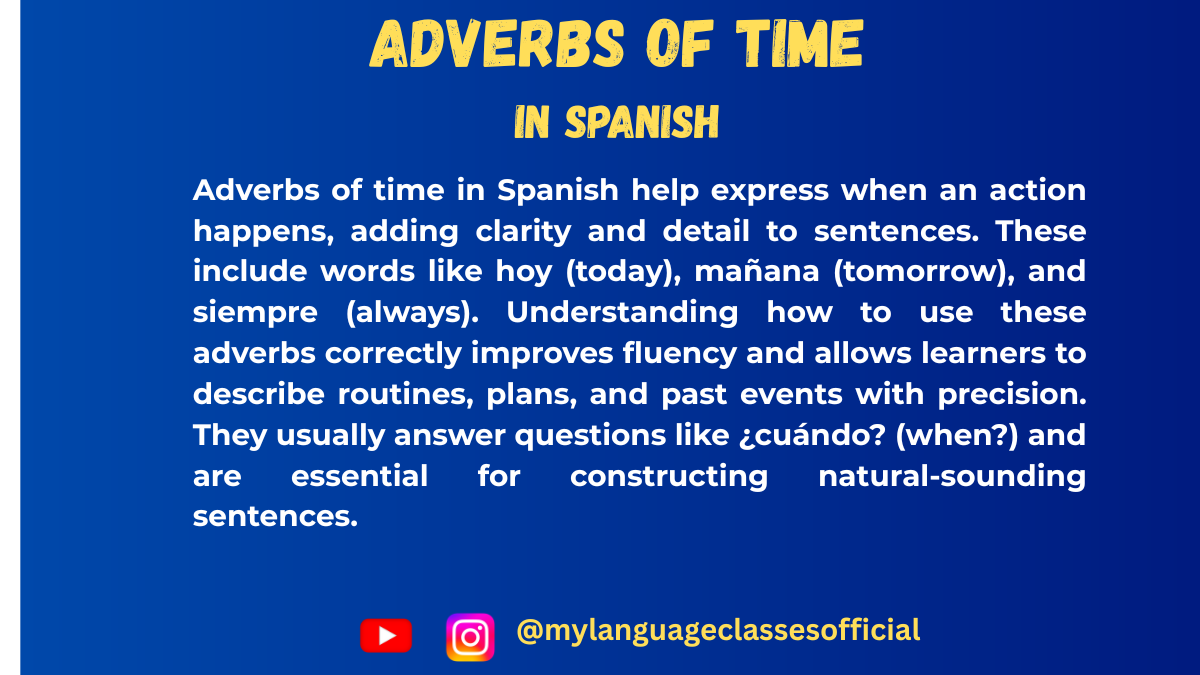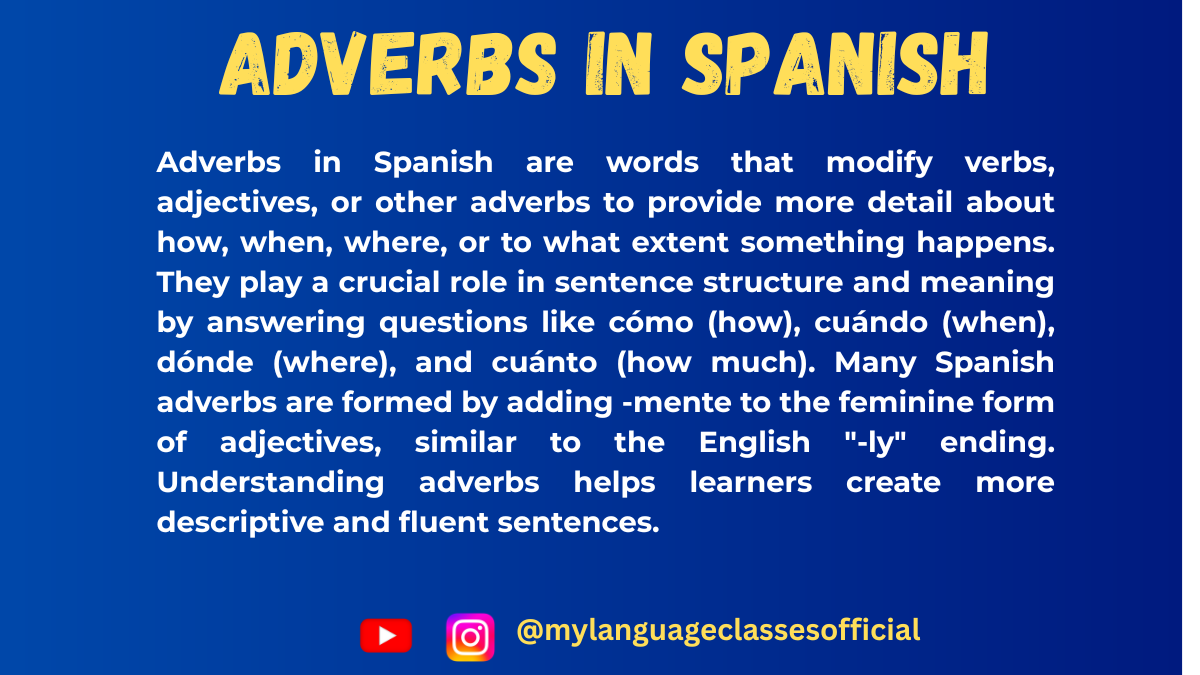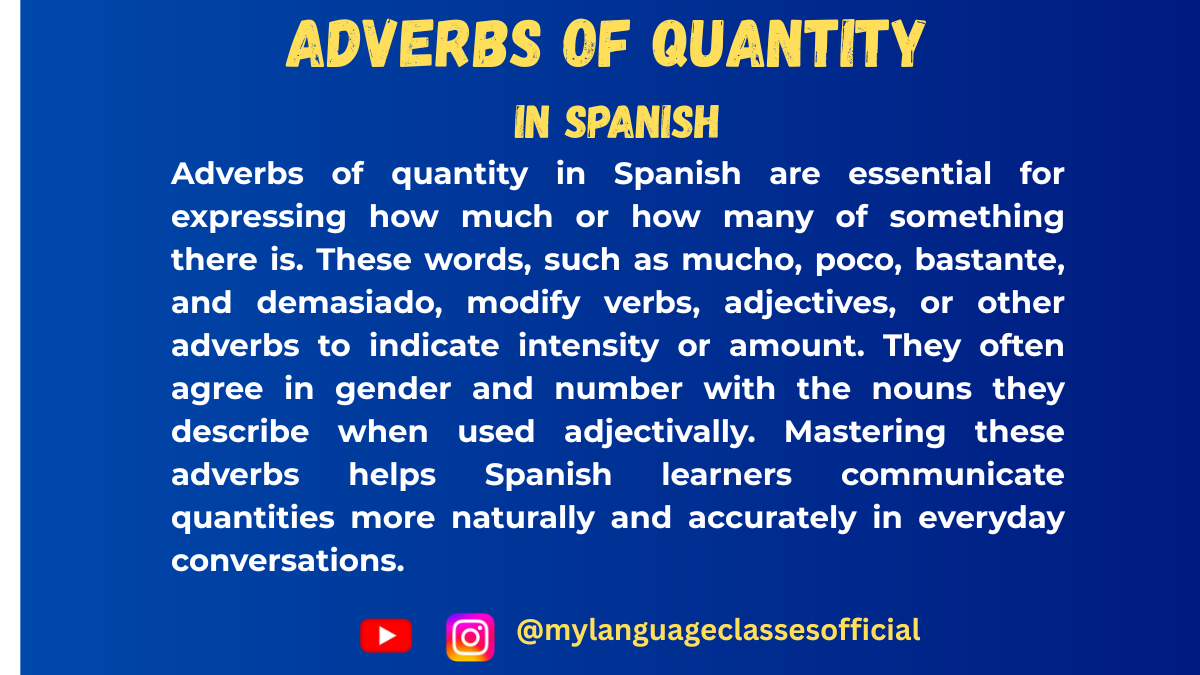Your cart is currently empty!
Tag: common Spanish adverbs
-

Adverbs of Place in Spanish: A Complete Guide
Adverbs of place (adverbios de lugar) are essential in Spanish to indicate where an action takes place. They help provide spatial context and are frequently used in daily conversations. In this blog, we will explore the most common adverbs of place, their meanings, and how to use them correctly in sentences.
Understanding Adverbs of Place
Adverbs of place describe the location of an action or object. They answer the questions: Where? (¿Dónde?) and To where? (¿Adónde?)
These adverbs do not change in gender or number, as adjectives do, but their placement and meaning depend on the sentence context.
Common Adverbs of Place and Their Meanings
Spanish Adverb Meaning Aquí Here Allí There (not too far) Allá Over there (far away) Cerca Near Lejos Far Encima On top Debajo Below, under Enfrente In front Detrás Behind Dentro Inside Fuera Outside Al lado Next to, beside Entre Between Alrededor Around
Common Expressions with Adverbs of Place
Here are some daily expressions using adverbs of place with their meanings and example sentences:
1. Aquí (Here)
- Estoy aquí. (I am here.)
- Pon el libro aquí. (Put the book here.)
- Aquí se come bien. (Here, one eats well.)
2. Allí / Allá (There / Over there)
- El coche está allí. (The car is there.)
- Allí vive mi abuela. (My grandmother lives there.)
- Vamos allá para ver la fiesta. (Let’s go over there to see the party.)
3. Cerca / Lejos (Near / Far)
- El supermercado está cerca. (The supermarket is near.)
- El aeropuerto está lejos de aquí. (The airport is far from here.)
- Mi casa está cerca del parque. (My house is near the park.)
4. Encima / Debajo (On top / Under)
- El libro está encima de la mesa. (The book is on top of the table.)
- El perro está debajo de la silla. (The dog is under the chair.)
- Las llaves están encima del escritorio. (The keys are on top of the desk.)
5. Enfrente / Detrás (In front / Behind)
- El cine está enfrente del restaurante. (The cinema is in front of the restaurant.)
- Juan está detrás de la puerta. (Juan is behind the door.)
6. Dentro / Fuera (Inside / Outside)
- Los niños están dentro de la casa. (The children are inside the house.)
- Voy a esperar fuera. (I will wait outside.)
How to Use Adverbs of Place Correctly?
1. Articles and Agreement
- Unlike adjectives, adverbs of place do not agree in gender or number.
- However, they often require a definite article (el, la, los, las) when specifying the location:
- Encima de la mesa (On top of the table)
- Debajo del coche (Under the car)
2. Adverbs with Prepositions
- Some adverbs need prepositions like de to clarify their meaning:
- Encima de, debajo de, detrás de, delante de
- El gato está debajo de la cama. (The cat is under the bed.)
3. Position in a Sentence
- Adverbs of place typically come after the verb or at the end of the sentence:
- El niño juega afuera. (The boy plays outside.)
- Nos vemos allí. (See you there.)
- In questions, adverbs of place often come at the beginning:
- ¿Dónde está tu mochila? (Where is your backpack?)
Adverbs of Place in Different Contexts
1. Motion vs. Static Position
- When describing movement towards a place, use hacia or para:
- Voy hacia allá. (I am going over there.)
- Camina para dentro. (Walk inside.)
- When indicating a fixed position, use adverbs alone:
- Estoy aquí. (I am here.)
2. Expressing Approximate Location
- Por aquí / Por allí (Around here / around there):
- Debe estar por aquí. (It must be around here.)
Conclusion
Adverbs of place are fundamental for effective communication in Spanish. By mastering their meanings, correct usage, and placement in sentences, you can confidently express spatial relationships in everyday conversations. Practice using them with different verbs and prepositions to sound more fluent and natural in Spanish!
Do you have any questions or need more examples? Let me know in the comments below!
If you enjoyed this lesson, be sure to check out more posts like this on my blog at My Language Classes. Don’t forget to subscribe my YouTube channel and follow me on Instagram for the latest language learning tips and lessons. Leave a comment below to share your thoughts, or ask any questions you have.
Happy learning! 😊
-

Adverbs of Time in Spanish: A Complete Guide
Adverbs of time (“los adverbios de tiempo”) are essential in Spanish to indicate when an action takes place. They help provide clarity and context to sentences, making conversations more precise. In this article, we will explore common Spanish adverbs of time, their meanings, examples, and grammatical considerations.
What Are Adverbs of Time?
Adverbs of time modify verbs, adjectives, or other adverbs by indicating the timing of an action. They answer questions like ¿Cuándo? (When?) and ¿Cada cuánto tiempo? (How often?).
Common Spanish Adverbs of Time
Here is a list of frequently used adverbs of time in Spanish along with their meanings and example sentences:
1. Adverbs for Specific Points in Time
- Hoy (Today)
- Hoy es un día especial. (Today is a special day.)
- Mañana (Tomorrow)
- Mañana voy al médico. (Tomorrow I am going to the doctor.)
- Ayer (Yesterday)
- Ayer llovió mucho. (Yesterday it rained a lot.)
- Ahora (Now)
- Ahora estoy ocupado. (Now I am busy.)
- Luego (Later)
- Voy al cine, luego te llamo. (I am going to the cinema, later I will call you.)
- Antes (Before)
- Antes de salir, apaga la luz. (Before leaving, turn off the light.)
- Después (After)
- Después de cenar, salimos a caminar. (After dinner, we go for a walk.)
2. Adverbs for Frequency
- Siempre (Always)
- Siempre me levanto temprano. (I always wake up early.)
- Nunca / Jamás (Never)
- Nunca fumo. (I never smoke.)
- Jamás lo volveré a hacer. (I will never do it again.)
- A menudo (Often)
- Voy al gimnasio a menudo. (I go to the gym often.)
- De vez en cuando (From time to time)
- De vez en cuando voy al teatro. (From time to time, I go to the theater.)
- Raramente (Rarely)
- Raramente veo televisión. (I rarely watch TV.)
- Casi nunca (Almost never)
- Casi nunca como comida rápida. (I almost never eat fast food.)
3. Adverbs for Duration
- Todavía / Aún (Still, yet)
- Todavía no he terminado. (I have not finished yet.)
- Ya (Already)
- Ya terminé la tarea. (I already finished the homework.)
- Por fin / Finalmente (Finally)
- Finalmente llegó el paquete. (The package finally arrived.)
- Desde entonces (Since then)
- Desde entonces no hemos hablado. (Since then, we have not spoken.)
- Mientras (While)
- Escucho música mientras estudio. (I listen to music while I study.)
Grammar and Usage Considerations
1. Placement in a Sentence
- In most cases, adverbs of time appear at the beginning or the end of a sentence:
- Hoy tengo clases. (Today I have classes.)
- Tengo clases hoy. (I have classes today.)
- Some adverbs, like ya, are placed before the verb:
- Ya terminé mi trabajo. (I already finished my work.)
2. Agreement and Gender Considerations
- Unlike adjectives, adverbs do not change in gender or number.
- However, some time expressions require articles or prepositions, such as:
- El lunes pasado (Last Monday) vs. Los lunes (On Mondays)
- En la mañana (In the morning) vs. Por la mañana (During the morning)
Forming Adverbs of Time from Adjectives
1. Regular Formation (Adding -mente)
Many adverbs are formed by adding -mente to the feminine singular form of adjectives:
- Rápido (Fast) → Rápidamente (Quickly)
- Frecuente (Frequent) → Frecuentemente (Frequently)
2. Irregular Formation
Some adverbs do not follow the regular -mente rule and must be memorized:
- Bien (Well), Mal (Badly), Tarde (Late), Temprano (Early)
- Example: Él llegó tarde a la reunión. (He arrived late to the meeting.)
3. Using Prepositional Phrases as Adverbs of Time
Some expressions function as adverbs when combined with prepositions:
- De vez en cuando (From time to time)
- Cada día (Every day)
- Hace un rato (A while ago)
Common Mistakes to Avoid
- Confusing “ya” and “todavía”:
- Ya means “already”: Ya hice mi tarea. (I already did my homework.)
- Todavía means “still”: Todavía estoy haciendo mi tarea. (I am still doing my homework.)
- Misplacing “nunca” in negative sentences:
- Correct: Nunca he estado en España. (I have never been to Spain.)
- Incorrect: No he estado nunca en España. (Although this is sometimes used in spoken Spanish, it’s not grammatically preferred.)
Conclusion
Adverbs of time are fundamental for constructing clear and accurate sentences in Spanish. Understanding their placement, variations, and common expressions will enhance your fluency. By practicing these adverbs in different contexts, you will develop a more natural and precise way of speaking Spanish.
If you enjoyed this lesson, be sure to check out more posts like this on my blog at My Language Classes. Don’t forget to subscribe my YouTube channel and follow me on Instagram for the latest language learning tips and lessons. Leave a comment below to share your thoughts, or ask any questions you have.
Happy learning! 😊
- Hoy (Today)
-

Exploring Spanish Adverbs
Adverbs are essential in Spanish, providing important details about actions—when, where, and how often they happen. Mastering adverbs will help you express yourself more clearly and accurately in everyday conversations. In this blog post, we’ll break down three important types of adverbs: adverbs of frequency, adverbs of time, and adverbs of place. Each type has its own role in enriching your sentences.
1. Adverbs of Frequency: How Often?
Adverbs of frequency tell us how often an action takes place. They are essential for describing habits, routines, and general tendencies in our daily lives. Common adverbs of frequency in Spanish include words like siempre (always) and nunca (never), which are often used to express regularity or lack thereof.
For example:
- Siempre (Always): Yo siempre tomo café por la mañana.
(I always drink coffee in the morning.) - Nunca (Never): Nunca llego tarde al trabajo.
(I never arrive late to work.)
Here’s a table summarizing common adverbs of frequency, their English meanings, and example sentences:
Adverbs of Frequency
Adverb (Spanish) English Meaning Example Sentence (Spanish) Translation (English) Siempre Always Yo siempre tomo café por la mañana. I always drink coffee in the morning. A menudo Often Ellos visitan a sus abuelos a menudo. They often visit their grandparents. Frecuentemente Frequently Los niños frecuentemente juegan en el parque. The children frequently play in the park. A veces Sometimes A veces leo libros en la biblioteca. Sometimes I read books in the library. Rara vez Rarely Ella rara vez come comida rápida. She rarely eats fast food. Nunca Never Nunca llego tarde al trabajo. I never arrive late to work. Tip: In Spanish, adverbs of frequency like siempre and nunca typically come before the verb, while others like a veces and frecuentemente can vary in position for emphasis.
2. Adverbs of Time: When?
Adverbs of time tell us when an action happens. They help us frame the timeline of a conversation, allowing us to specify moments in time—whether something happens right now, in the past, or in the future.
For example:
- Ahora (Now): Estoy estudiando ahora. (I am studying now.)
- Mañana (Tomorrow): Mañana tengo una reunión importante. (Tomorrow I have an important meeting.)
Here’s a table with some common adverbs of time and examples:
Adverbs of Time
Adverb (Spanish) English Meaning Example Sentence (Spanish) Translation (English) Ahora Now Estoy estudiando ahora. I am studying now. Hoy Today Hoy vamos al cine. Today we are going to the cinema. Mañana Tomorrow Mañana tengo una reunión importante. Tomorrow I have an important meeting. Ayer Yesterday Ayer cociné una paella deliciosa. Yesterday I cooked a delicious paella. Tarde Late Llego tarde a la clase de español. I am late for the Spanish class. Temprano Early Siempre llegamos temprano al aeropuerto. We always arrive early at the airport. Tip: When using adverbs of time, be sure to place them where they make the most sense contextually—before or after the verb depending on what you want to emphasize.
3. Adverbs of Place: Where?
Adverbs of place answer the question “Where?” These adverbs describe the location of an action. They are especially helpful in giving directions or providing specific details about where something happens. Common adverbs of place include aquí (here), allí (there), cerca (close), and lejos (far).
For example:
- Aquí (Here): Ven aquí, por favor. (Come here, please.)
- Lejos (Far): Su oficina está lejos de la estación de tren. (Their office is far from the train station.)
Here’s a table summarizing common adverbs of place:
Adverbs of Place
Adverb (Spanish) English Meaning Example Sentence (Spanish) Translation (English) Aquí Here Ven aquí, por favor. Come here, please. Allí There Dejé mis llaves allí. I left my keys there. Cerca Close/Nearby Hay un supermercado cerca de mi casa. There’s a supermarket near my house. Lejos Far Su oficina está lejos de la estación de tren. Their office is far from the train station. Dentro Inside El gato está dentro de la caja. The cat is inside the box. Fuera Outside Los niños juegan fuera. The children play outside. Tip: Adverbs of place often go after the verb, but they can sometimes appear at the beginning of the sentence for emphasis.
Final Thoughts
Adverbs are powerful tools in Spanish that help add context to your sentences. By using adverbs of frequency, adverbs of time, and adverbs of place, you can make your speech or writing much more expressive. Practice using them in different contexts, and soon they will become a natural part of your Spanish communication.
¡Buena suerte en tu aprendizaje! (Good luck with your learning!)
If you enjoyed this lesson, be sure to check out more posts like this on my blog at My Language Classes. Don’t forget to subscribe my YouTube channel and follow me on Instagram for the latest language learning tips and lessons. Leave a comment below to share your thoughts, or ask any questions you have.
Happy learning! 😊
- Siempre (Always): Yo siempre tomo café por la mañana.

